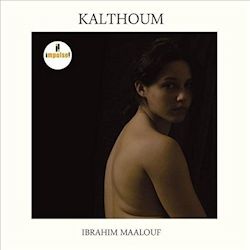Ibrahim Maalouf – Red & Black Light
-
Free Spirit
- Essentielles
- Goodnight Kiss
- Elephant’s Tooth
- Red & Black Light
- Escape
- Improbable
- Run the World (Girls)
Ibrahim Maalouf (trumpet): Eric Legnini (keyboards), François Delporte (guitar) Stéphane Galland (drums)
Recorded Ivry-sur-Seine [42:03]
Ibrahim Maalouf - Kalthoum
1. Introduction
2. Overture I
3. Overture II
4. Movement I
5. Movement II
6. Movement III
7. Movement IV
Ibrahim Maalouf (trumpet): Mark Turner (saxophone): Frank Woeste (piano): .Larry Grenadier (double bass), Clarence Penn (drums)
Recorded NYC [51:34]
Ibrahim Maalouf has two very different albums here. Working from promo copies I have some idea of the rationale from the documentation that came with the
discs but it would, in any case, be relatively easy to reconstruct the reasoning behind them. With a Beyoncé song included in
Red and Black Light,
the focus is on strong women – though the modus operandi is largely that of electro-pop. With a polyrhythmic base
Free Spirit is a jolly opener,
with lashings of overdubbing, though
Essentielles is perhaps less essential, a heavy pop vibe dominating and lots of studio ‘work’ necessary to
fabricate a wall of sound. There’s a North African ethos to Maalouf’s trumpet playing in
Elephant’s Tooth, whereas the title piece is an
atmospheric dance track. The trumpet vibe in
Escape, strongly Moroccan cum Egyptian though it is, comes strangely close at times to Eastern
European music – it sounds almost Klezmer-like, in fact. The drum beat that propels
Improbable so relentlessly is outdone by the electro closer,
Run the World (Girls). None of this has very much to do with jazz.
The other album, Kalthoum, is another Ode to Women, focusing on the Egyptian singer Oum Kalthoum. It was recorded and mixed in New York with some
top notch players and makes far more of an impression. Some delicate Classical-inspired pianism animates the introduction and though the saxophone of Mark
Turner insinuates some lyrical-North African lines the more straight-ahead ethos of this album stands in strong relief to its companion. Themes are quite
strong, there are moments in which the spirit of someone like Ziggy Elman seems to be invoked, knowingly or not, and grooves are built up attractively and
often punchily. The tracks are divided somewhat pompously into an introduction, two overtures – what’s wrong with just the one? – and four movements. But
the trumpet and sax solos and unisons and the occasionally rolling piano lines show a level of creativity far removed from the relative banalities of Red and Black Light. Cumulatively, however too much of this is too repetitious. Adherence and dependence on repetitive stock phrases and tired
Klezmer-derived licks means that themes seldom truly cohere, even when they begin promisingly. Sometimes it’s as if the musicians are trying to pack in too
many things. The result is a degree of athletic incoherence, and the two long final tracks exemplify the problem all too graphically. Inside this baggy
album there was a streamlined version waiting to emerge – and it would have been the better for it.
Jonathan Woolf
See another review by James Poore

